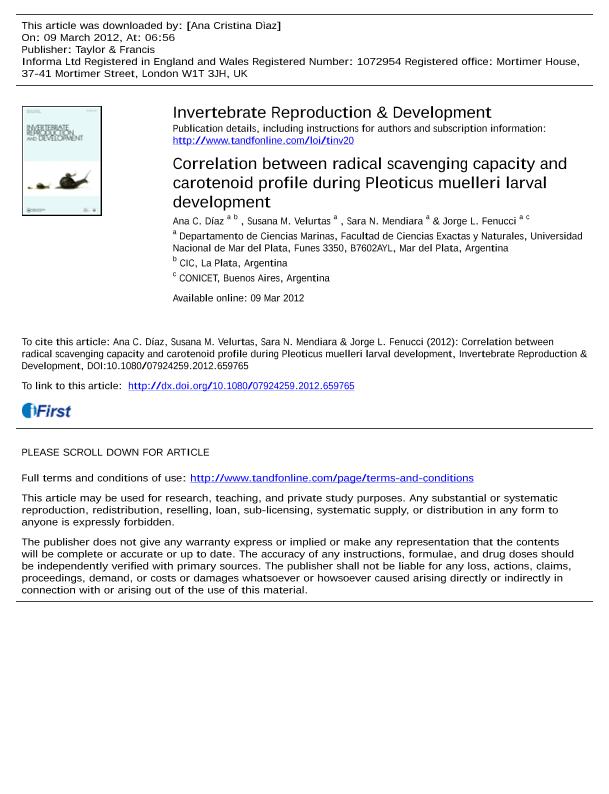Artículo
Correlation between radical scavenging capacity and carotenoid profile during Pleoticus muelleri larval development
Fecha de publicación:
02/2013
Editorial:
Int Science Services/Balaban Publishers
Revista:
Invertebrate Reproduction & Development
ISSN:
0792-4259
Idioma:
Inglés
Tipo de recurso:
Artículo publicado
Clasificación temática:
Resumen
The purpose of this study was to measure the concentration of carotenoids and properties which occur in tissues to neutralize free radicals during ontogeny of Pleoticus muelleri. The stages of nauplius, protozoea, mysis and postlarvae of 1, 6, 10, 26, 30 days were examined from hatchery raised postlarvae from wild females. The β-carotene and the astaxanthin from the lyophilized tissue were quantified using a ultraviolet-visible spectrophotometer. Free radicals scavenging properties of tissues extracts were evaluated by electron paramagnetic resonance (EPR). The reaction of protective substances was followed with the 1,1-diphenyl-2- picryhydrazyl (DPPH) radical. The concentration of carotenoids of the whole larvae and postlarvae ranged from 1.72 to 87.04 μg g-1 for β-carotene, and 2.26 to 19.86 μg g-1 for astaxanthin. All the larval and postlarvae stages showed a protective capacity. In the stages of mysis, postlarvae 1 and 30 the homogenates were monitored without DPPH. The undefined EPR signal was quantified and considered as a "pool" of persistent radicals, with a concentration about 10-5 M. A relationship was observed between the concentration of carotenoids and the protective capacity of the homogenate. The postlarvae stages had a high concentration of carotenoids and the greatest protective capacity.
Palabras clave:
Carotenoid
,
Crustacea
,
Dpph
,
Larval Rearing
,
Penaeoidea
,
Scavenging Capacity
Archivos asociados
Licencia
Identificadores
Colecciones
Articulos(IIMYC)
Articulos de INSTITUTO DE INVESTIGACIONES MARINAS Y COSTERAS
Articulos de INSTITUTO DE INVESTIGACIONES MARINAS Y COSTERAS
Citación
Díaz, Ana Cristina; Velurtas, Susana María; Mendiara, Sara Noemí; Fenucci, Jorge Lino; Correlation between radical scavenging capacity and carotenoid profile during Pleoticus muelleri larval development; Int Science Services/Balaban Publishers; Invertebrate Reproduction & Development; 57; 1; 2-2013; 43-48
Compartir
Altmétricas




